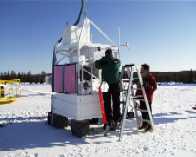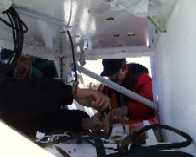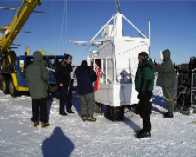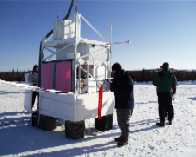 A.....
A..... B....
B.... C.....
C..... D.....
D..... E
E
A Most Excellent Adventure
in
Kiruna, Sweden
January-March 2000
(click on pictures to enlarge)
OMS Balloon Launch 000305
Photos by Greg Flesch
In addition to the aircraft platforms, balloon instruments are being used in the SOLVE project. One of the balloon packages is the OMS IN SITU which is a relatively small gondola which is launched with a four million cubic feet balloon. The balloon launches are done at the Esrange facility 40 km east of Kiruna. The balloon is made of thin plastic and is filled with helium. When it ascends, the helium expands and fills the plastic to make a sphere that is approximately 100 meters in diameter. Picture A shows Bruce and Christoph working on the gondola. Picture B shows Chris and Dave while picture C is of Chris, Valentin, Bob, Bruce, and Jim. Picture D is of Valentin, Dave, and Bob. Picture E shows two spectators in the distance on a mound of snow seeking a better view. The person on the right is Ross.
Before the balloon is launched, the right amount of helium is put into the balloon via the fill tubes shown at each side of the bubble in picture A. The helium does not occupy the complete volume of the balloon at ground pressure, so the surface area is minimized to a bubble also shown in picture A. Most of the balloon at this point is lying on canvas mats on the ground. The other end of the balloon is attached to a parachute which is attached to the gondola containing the experiments. The payload is lifted off the ground by a crane. When the bubble is released from the clutch, the wind carries it up and over the crane. When the balloon is directly over the gondola, the crane releases the payload and it ascends to about 140,000 feet at about 1000 feet per minute. Picture B shows the balloon just after release. Notice the flattening at the top of the bubble and the slack in the rest of the balloon. The bubble is contained with a collar for a few minutes, and then the collar is removed and the helium is free to expand into the rest of the balloon. Pictures C through G show the first part of the ascent, while picture H is a good shot of the gondola and parachute. At altitude, the helium may be valved out of the balloon or ballast may be dropped from the payload to maintain a float altitude. Since the balloon is completely driven by the wind, it must be left in the air until a good landing location is possible. When the balloon is in position, a radio command is sent which cuts the payload and parachute from the balloon and destroys the balloon. The payload is tracked to the ground and is recovered by a helicopter, hopefully to be flown again. This particular payload has been flown 9 times in various places around the world including New Mexico, Alaska, Brazil, and Sweden.